代词分类专项讲解2022年中考英语语法总复习(word版)
文档属性
| 名称 | 代词分类专项讲解2022年中考英语语法总复习(word版) | 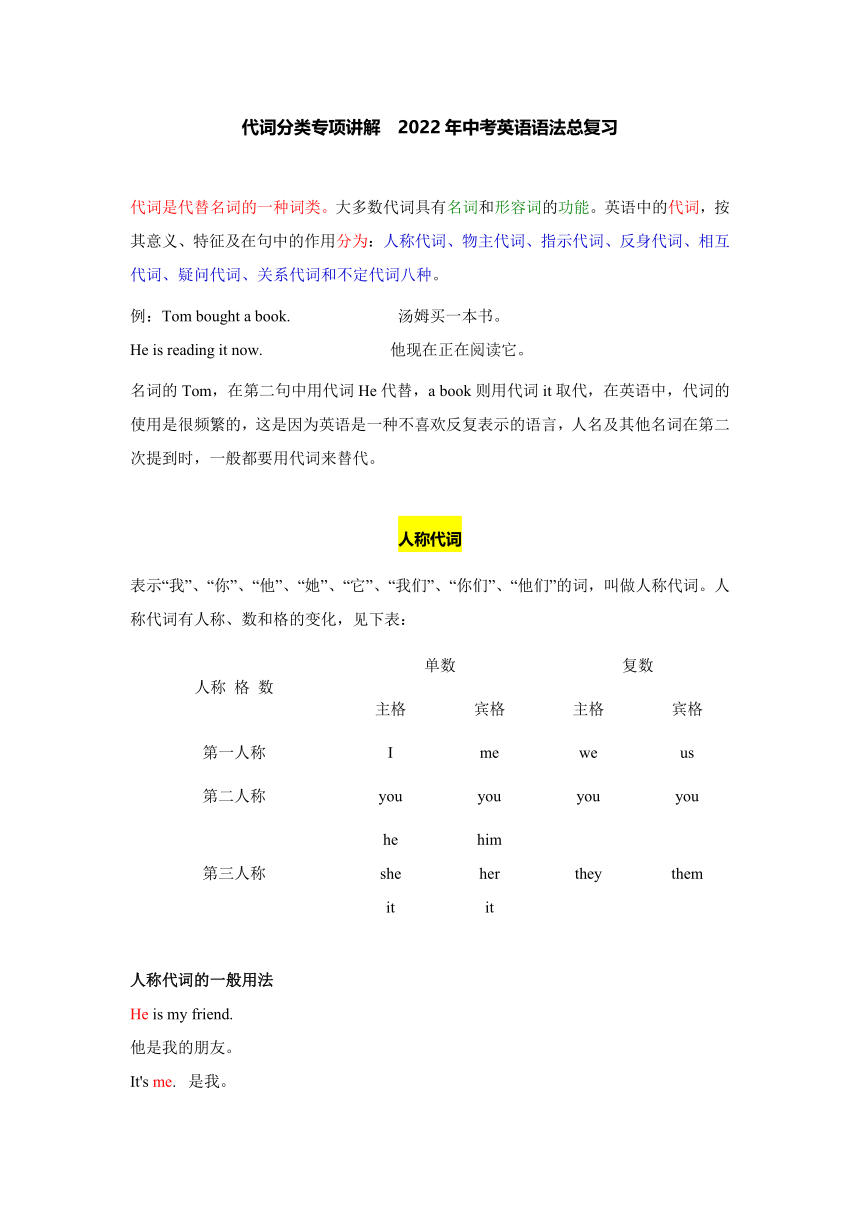 | |
| 格式 | doc | ||
| 文件大小 | 127.9KB | ||
| 资源类型 | 教案 | ||
| 版本资源 | 通用版 | ||
| 科目 | 英语 | ||
| 更新时间 | 2022-01-19 10:06:06 | ||
图片预览

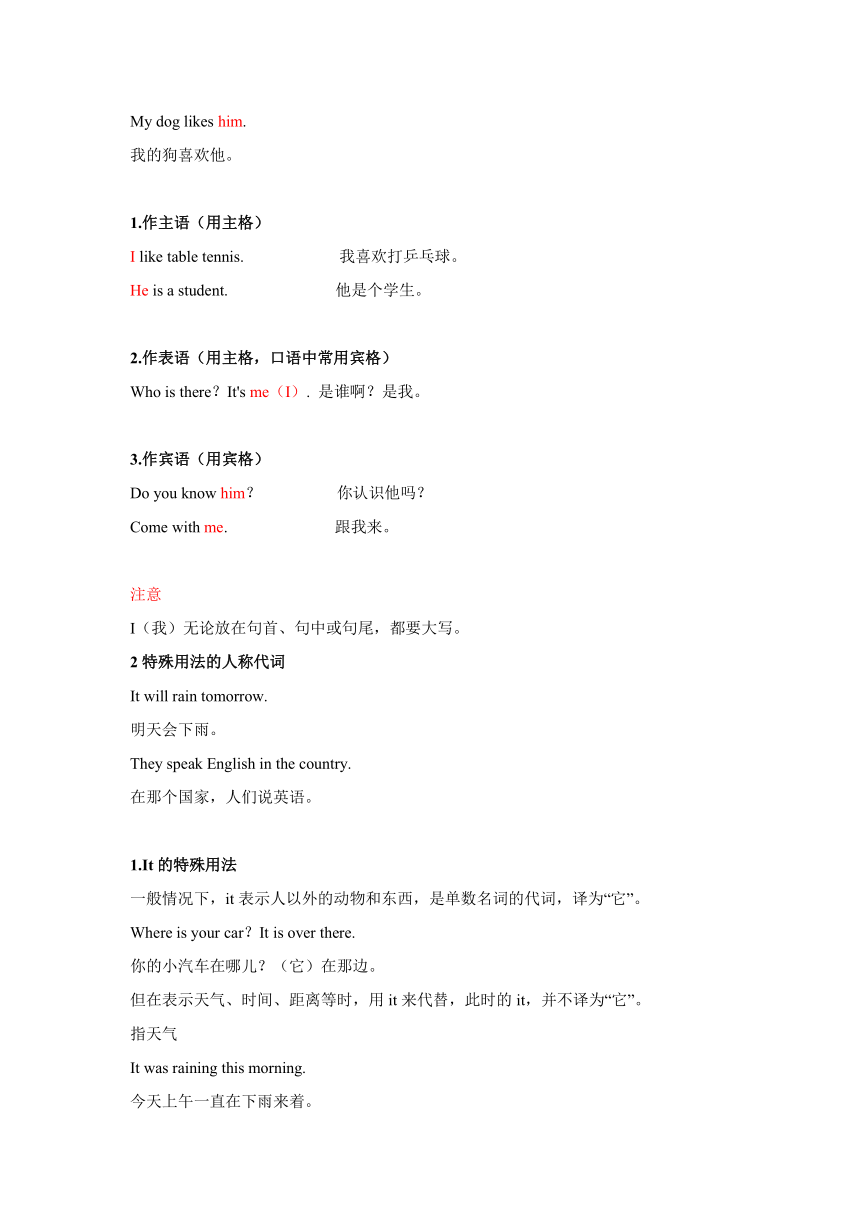
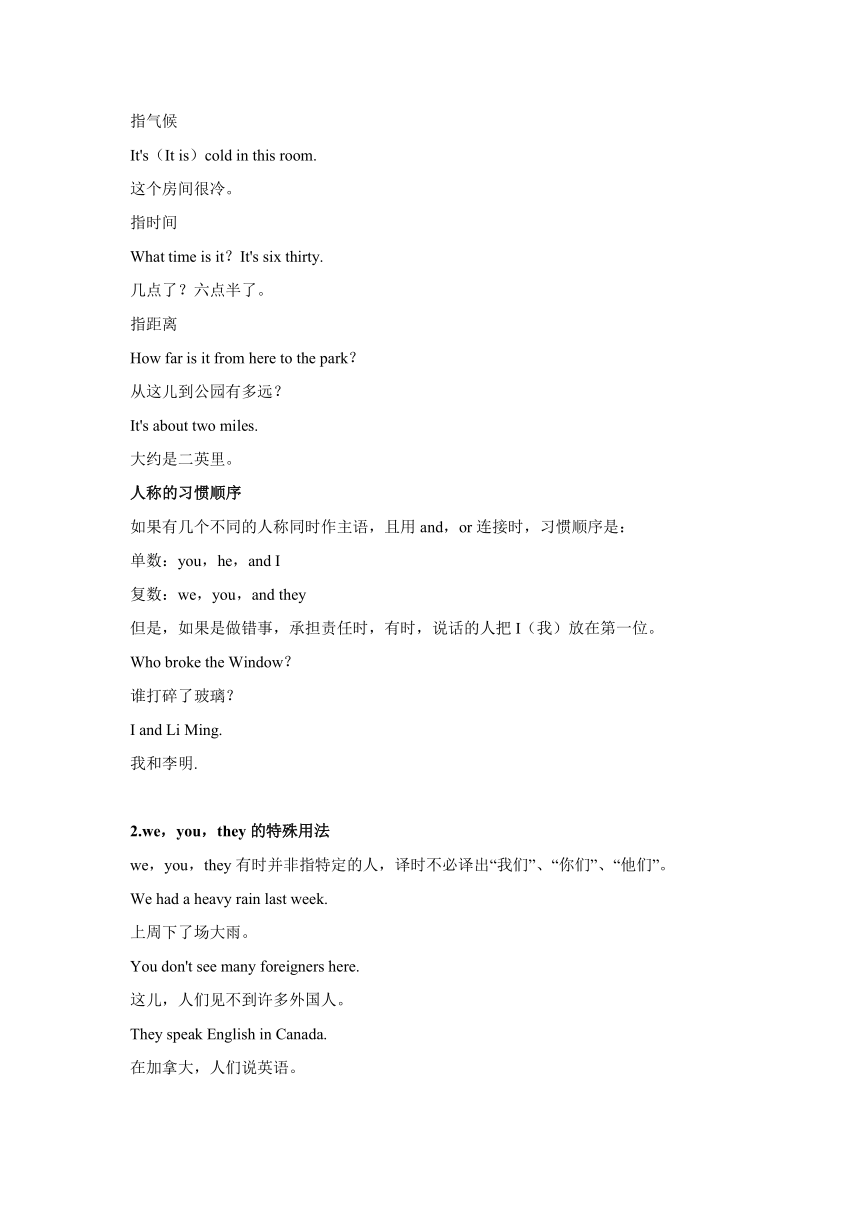
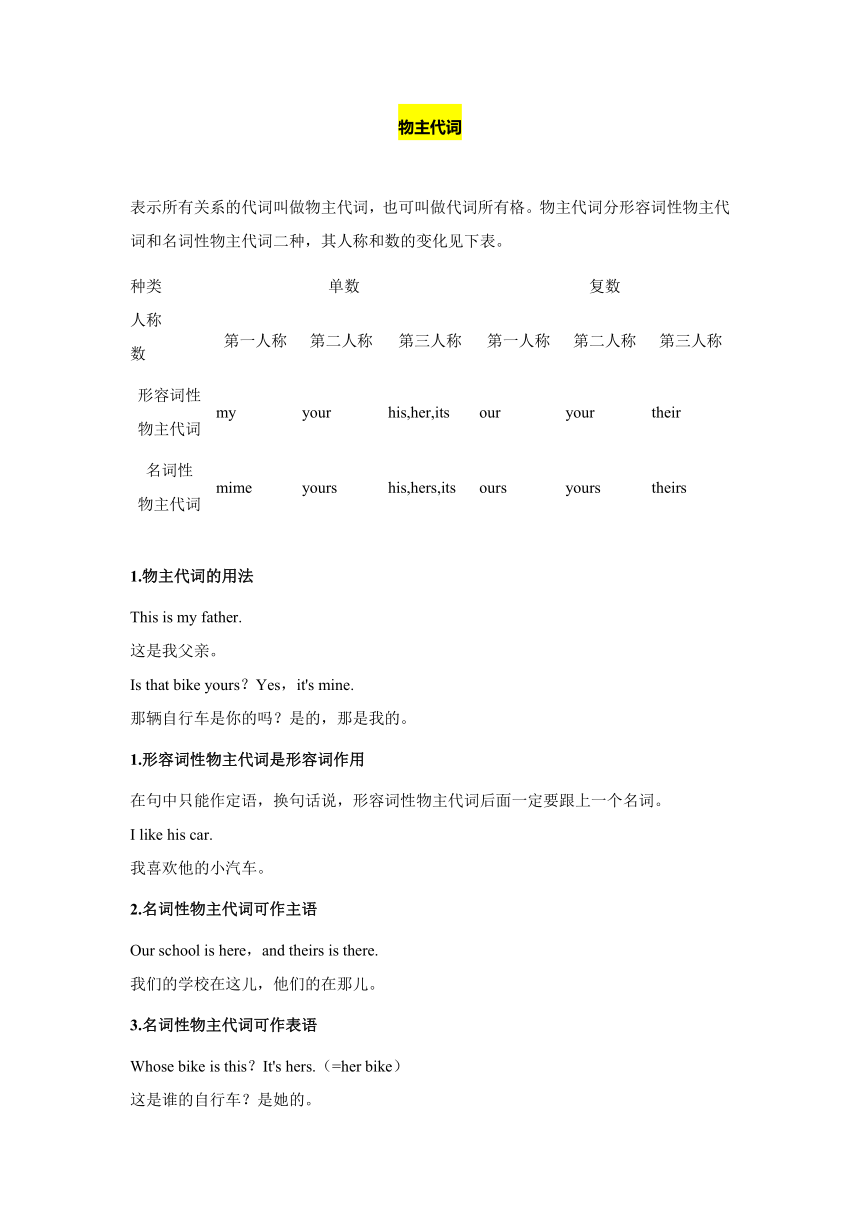
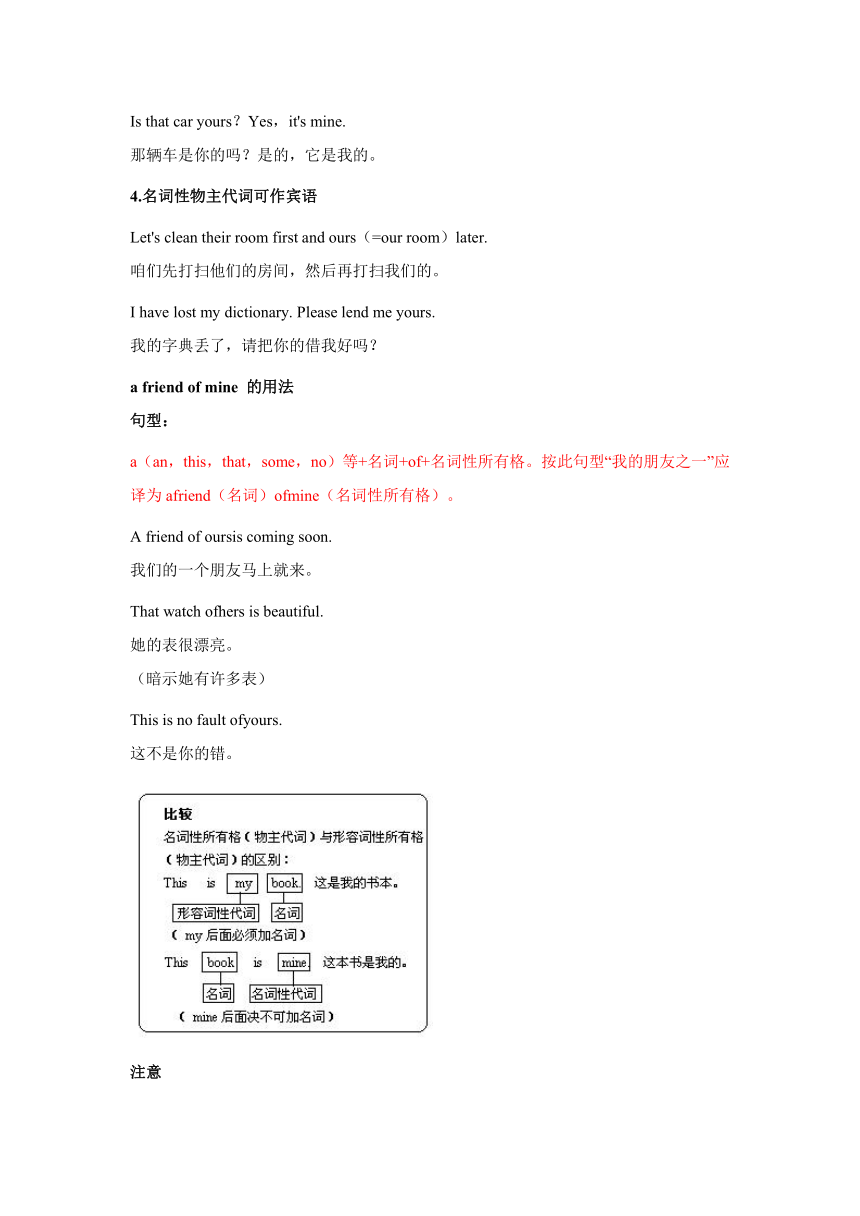
文档简介
代词分类专项讲解 2022年中考英语语法总复习
代词是代替名词的一种词类。大多数代词具有名词和形容词的功能。英语中的代词,按其意义、特征及在句中的作用分为:人称代词、物主代词、指示代词、反身代词、相互代词、疑问代词、关系代词和不定代词八种。
例:Tom bought a book. 汤姆买一本书。
He is reading it now. 他现在正在阅读它。
名词的Tom,在第二句中用代词He代替,a book则用代词it取代,在英语中,代词的使用是很频繁的,这是因为英语是一种不喜欢反复表示的语言,人名及其他名词在第二次提到时,一般都要用代词来替代。
人称代词
表示“我”、“你”、“他”、“她”、“它”、“我们”、“你们”、“他们”的词,叫做人称代词。人称代词有人称、数和格的变化,见下表:
人称 格 数 单数 复数
主格 宾格 主格 宾格
第一人称 I me we us
第二人称 you you you you
第三人称 he
she
it him
her
it they them
人称代词的一般用法
He is my friend.
他是我的朋友。
It's me. 是我。
My dog likes him.
我的狗喜欢他。
1.作主语(用主格)
I like table tennis. 我喜欢打乒乓球。
He is a student. 他是个学生。
2.作表语(用主格,口语中常用宾格)
Who is there?It's me(I). 是谁啊?是我。
3.作宾语(用宾格)
Do you know him? 你认识他吗?
Come with me. 跟我来。
注意
I(我)无论放在句首、句中或句尾,都要大写。
2 特殊用法的人称代词
It will rain tomorrow.
明天会下雨。
They speak English in the country.
在那个国家,人们说英语。
1.It的特殊用法
一般情况下,it表示人以外的动物和东西,是单数名词的代词,译为“它”。
Where is your car?It is over there.
你的小汽车在哪儿?(它)在那边。
但在表示天气、时间、距离等时,用it来代替,此时的it,并不译为“它”。
指天气
It was raining this morning.
今天上午一直在下雨来着。
指气候
It's(It is)cold in this room.
这个房间很冷。
指时间
What time is it?It's six thirty.
几点了?六点半了。
指距离
How far is it from here to the park?
从这儿到公园有多远?
It's about two miles.
大约是二英里。
人称的习惯顺序
如果有几个不同的人称同时作主语,且用and,or连接时,习惯顺序是:
单数:you,he,and I
复数:we,you,and they
但是,如果是做错事,承担责任时,有时,说话的人把I(我)放在第一位。
Who broke the Window?
谁打碎了玻璃?
I and Li Ming.
我和李明.
2.we,you,they的特殊用法
we,you,they有时并非指特定的人,译时不必译出“我们”、“你们”、“他们”。
We had a heavy rain last week.
上周下了场大雨。
You don't see many foreigners here.
这儿,人们见不到许多外国人。
They speak English in Canada.
在加拿大,人们说英语。
物主代词
表示所有关系的代词叫做物主代词,也可叫做代词所有格。物主代词分形容词性物主代词和名词性物主代词二种,其人称和数的变化见下表。
种类人称数 单数 复数
第一人称 第二人称 第三人称 第一人称 第二人称 第三人称
形容词性
物主代词 my your his,her,its our your their
名词性
物主代词 mime yours his,hers,its ours yours theirs
1.物主代词的用法
This is my father.
这是我父亲。
Is that bike yours?Yes,it's mine.
那辆自行车是你的吗?是的,那是我的。
1.形容词性物主代词是形容词作用
在句中只能作定语,换句话说,形容词性物主代词后面一定要跟上一个名词。
I like his car.
我喜欢他的小汽车。
2.名词性物主代词可作主语
Our school is here,and theirs is there.
我们的学校在这儿,他们的在那儿。
3.名词性物主代词可作表语
Whose bike is this?It's hers.(=her bike)
这是谁的自行车?是她的。
Is that car yours?Yes,it's mine.
那辆车是你的吗?是的,它是我的。
4.名词性物主代词可作宾语
Let's clean their room first and ours(=our room)later.
咱们先打扫他们的房间,然后再打扫我们的。
I have lost my dictionary. Please lend me yours.
我的字典丢了,请把你的借我好吗?
a friend of mine 的用法
句型:
a(an,this,that,some,no)等+名词+of+名词性所有格。按此句型“我的朋友之一”应译为afriend(名词)ofmine(名词性所有格)。
A friend of oursis coming soon.
我们的一个朋友马上就来。
That watch ofhers is beautiful.
她的表很漂亮。
(暗示她有许多表)
This is no fault ofyours.
这不是你的错。
注意
冠词a(an,the)和this,that,some等词后不能加所有格。
(×)a my friend
指示代词
表示“这个”、“那个”、“这些”、“那些”等指示概念的代词叫做指示代词。指示代词有this,that,these,those等。
this(复数形式是these),是指在时间上或空间上离说话人较近的人或物。
that(复数形式是those),是指在时间上或空间上离说话人较远的人或物。
1) 指示代词的基本用法(在句子中可作主语、表语、宾语和定语)
This is my doll. That is Mary's。
这是我的洋娃娃,那是玛丽的。
1.作主语
That is a good idea.
那是个好主意。
2.作表语
What I want is that(this).
我想要的是那(这)个。
3.作宾语
You like this but I like that.
你喜欢这个,而我喜欢那个。
4.作定语
What is the use of those books?
那些书有什么用处呢?
2) 指示代词的特殊用法
The history of China is as interesting as that of America.
中国的历史和美国的历史一样有趣。
1.为了避免重复,可用that,those代替前面提到过的名词。但是this,these不可代替。
The weather of Kunming is better than that(=the weather)of Beijing.
北京的天气不如昆明。
The radios made in Shanghai are as good asthose(=the radios)made in Tianjing.
上海生产的收音机和天津生产的一样好。
Her interests are different from those(=the interests)of her childhood.
她的兴趣和童年时代不同了。
2.this,that有时可代替句子或句中的一部分。
He was ill. That's why he didn't come.
(that作主语,代替He was ill.)
他病了,那就是他没来的原因。
He broke the window,and that cost him 10dollars.
他打破了窗玻璃,那(打破玻璃这件事)要花费他10美元。
反身代词·相互代词
表示“我自己”、“你自己”、“他自己”、“我们自己”、“你们自己”和“他们自己”等的代词,叫做反身代词。也有称为“反身代词”的。表示相互关系的代词叫做相互代词,有each other和one another两组,但在运用中,这两组词没什么区别。
1) 反身代词
She was talking to herself.
她自言自语。
1.反身代词的种类
英语中反身代词是由人称代词或物主代词加后缀-self或-selves构成,有人称和数的变化,见右表:
人称 数 单数 复数
第一人称 myself ourselves
第二人称 yourself yourselves
第三人称 himself herself itself themselves
2.反身代词的用法
a.主要用于担任同位语以加强语气,在句中的位置较灵活。
I cooked it myself(=I myself cooked it).
我自己亲自做的饭。
I spoke to the chairman himself.
我对主席本人讲。
b.作宾语(表示动作返回到动作执行者本身,即主语和宾语是指同一个或同一些人或物)
Mary saw herself in the mirror.
玛丽在镜子中看见了她自己。
比较
Mary saw her in the mirror.
玛丽在镜子中看见了她。(另外一个人)
Einstein taught himself advanced maths.
爱因斯坦自学(自己教自己)高等数学。
c.作表语
He is not quite himself today.
他今天情绪有点反常。
d.介词+反身代词
Rose said to himself,“Where am I?”
罗斯自言自语,“我在哪儿呢?”
I went to the post office by myself.
我一个人去邮局。(我单独地,一个人去的;没有别人帮助去的那儿。相当于alone或without help)
比较
I went to the post office myself.
我亲自去的邮局。
(强调不需要别人去,是我自己去的)
注意
反身代词的构成
第—、第二人称是:形容词性所有格+self(或selves)
myself,yourself,ourselves,yourselves;
第三人称全是人称代词的宾格+self(或selves)
himself,herself,itself,themselves。必背!
say to~self
心里想着;自言
自语
for~self
为自己
by~self
独自地;独立
2) 相互代词
Tom and Mary love each other.
汤姆和玛丽彼此相爱。
1.相互代词的形式
通格(包括主格和宾格): each other;one another。
所有格:each other's;one another's。
2.相互代词的用法
a.宾语
They help each other(one another).
他们互相帮助。
Don't talk to each other(one another).
不要互相说话。(each other是介词to的宾语)
b.所有格形式作定语
We should point out each other's(one another's) shortcomings.
我们应该指出彼此的缺点。
They know each other's favourite(s).
他们彼此了解各自的爱好。
你们常通信吗?
Do you often write to each other?
他们现在不常见面了。
They don't often see each other now.
注意
有时,在中文字面上没有“互相”、“彼此”等字,但译成英语时要用eachother(互相、彼此)。
不定代词
不是指明代替任何特定名词的代词叫做不定代词。常见的不定代词有all,both,each,every,some,any,many,much,(a)few,(a)little,one,ones,either,neither,other,another,no,none以及含有some-,any-,no-等的合成代词(如:anybody,something,no one)。这些不定代词大都可以代替名词和形容词,在句中作主语、宾语、表语和定语,但none和由some,any,no,every+thing,-body,-one构成的复合不定代同(如somebody等)只能作主语、宾语或表语;every和no只能作定语。(这些词作定语时,有些语法书称之为形容词)下面我们把一些主要的不定代词用法归纳如下:
1) one的用法
数 单数 复数 人称 物主代词 反身代词
one ones one's oneself
1.one(一个),可以指人,也可以指物。在句中可作主语、宾语和定语。
one(主语)should not praise oneself(宾语).
一个人不应炫耀自己。(one作主语和宾语)
If one wants to visit the city,one must find one's own guide.
如要参观这个城市,得自己找向导。
2.one,ones(one的复数形式)可用来代替前面出现过的少数名词,以避免重复。
Do you have a car?Yes,I have one.
你有一辆小汽车吗?是的,我有一辆。
I like small cars better than large ones.
我喜欢小汽车,不喜欢大汽车。
3.one的前面可用this,that,the,which等词修饰。
There are three pens,which one is yours,this one or that one or the one in the pencil-box?
这儿有三支钢笔,哪一支是你的?这支?那支?还是在铅笔盒里的那支?
4.a+形容词+one这一形式,经常见到或使用。
I have an old bike,but he has a new one.
我有辆旧自行车,他有辆新的。
own后面不用one
Your shoes don't fit me, I'd better wear my own.
我穿你的鞋不合适,我最好还是穿我自己的。
比较it和one的比较
it用来指特定的东西(the+名词);而one则用于替代不特定的东西(a,an+名词)
You have a pen,can I use it(=the pen)?
你有一支钢笔,我可以用它(这支钢笔)吗?(特指)
Do you have a pen?Yes,I have one(=a pen).
你有钢笔吗?是的,我有一支。(泛指)
2) some,any的用法
I have some money in my pocket,but it is not enough.
Do you have any?
我口袋里有一些钱,但不够,你有钱吗?
1.some,any可与单、复数可数名词和不可数名词连用。some一般用于肯定句中,any一般用于否定旬、疑问句和条件句中。
I have some science books.
我有一些科技书。(some在肯定句中译为一些)
There is some ink in the bottle.
瓶子里有一些墨水。
I haven't any money.(=I have no money.)
Do you have any?
我一分钱都没有了,你有(钱吗)?
注意
not…any =no…
any在否定句、问句中不须译出来。
You can ask me if you have any questions.
(条件句)
如果你有任何问题,你都可以问我。
2.some,any与-thing,-body,-one构成的合成词的用法与some,any一样。
我有重要的事告诉你。
I don't know anything about it .(I know nothing about it .)
关于这件事,我什么都不知道。
Anybody can do it.
任何人都可以做这件事。
注意
something,anything,nothing三者跟形容词时,形容词要放在它们的后面。
3.在疑问句中,一般不用some,只有当问句表示一种邀请或请求,或期待一个肯定的回答时才能用some。
Will you have some tea?
你喝茶吗?(表邀请)
Did somebody call me this morning?
今天上午有人给我打电话吧?(表可能已约好)
4.在否定句中,some表示半否定,any表示全否定。
I don't know some of you.
我只认识你们中的一些人。(我不会认识你们)
I don't know any of you.
你们,我一个也不认识。
5.some用于单数可数名词前时,表示“某个”,而不是“一些”。
This morning some boy asked for you.
今天上午,有个男孩要求见你。
There must be some reason for what he's done.
他干这些事,肯定有某种原因。
比较
Is there anything to eat?
有什么吃的吗?
(不知有没有,只是问一问)
Is there something to eat?
有一些吃的吧?
(希望,而且断定会有)
3) other,another的用法
种类 数 单数 复数
泛指 another = an other other (boys) others
特指 the other the other (boys) the others
功能 用作主语、宾语、定语 用作定语 用作主语、宾语
1.another(=an other),别的、另一个,泛指众多中一个,一般后面接单数名词,前面不能加定冠词。
This book is too difficult for me.
Will you please give me another one(=another book)?
这本书对我而言太难了,可以给我另一本吗?
(another是指许多书中的一本,作为定语)
I don't like this one. Show me another.
我不喜欢这个,给我看看另一个好吗?
(another作宾语)
He got three books;one is a dictionary,another is a play,the third is a grammar.
他买了三本书,一本是字典,另一本是剧本,还有一本是语法书。(another作主语)
有时another可以用在复数名词前译为“再、又”。
You may stay for another ten days.
你可以再住十天。
2.the other表示两个中的一个,常与one连用。
one…the other…
I have two pencils;one is red;
(and)the other is blue.
我有两支铅笔,一支是红的,另一支是蓝的。
There are only two books left. But I don't like this one. Will you please show me the other?
只剩下二本书了。可我不喜欢这一本,请给我另一本好吗?
必背!
惯用词组
each other
one another
互相
one after another
一个接一个
the other day
前几天
3.other+名词=others(别的)
Some are listening to the radio,others are watching TV.
一些人在听广播,一些人在看电视。
Some students went to the Summer Palace. Other students(=others)stayed at home last Sunday.
上周日,一些同学去颐和园,一些同学(还有同学)呆在家里。
4. the other +名词=the others,译为其余的,相当于the rest。
There are thirty students in our class. Twenty are girls. The other students(=the others)are boys.
我们班有三十个学生,二十名女孩,其余的都是男孩。
Some of the pencils are red. The others(=the other pencils)are green.
有些铅笔是红的,其余的都是绿的。
比较
Some of the pencils are red,others(=other pencils)are green.
有些铅笔是红的,还有一些是绿的。
(暗示可能还有些笔是别的颜色的:白色的、黄色的……)
4) all,both的用法
All of them go to the movies.
他们都去看电影。
Both of my parents are healthy.
我的双亲身体都健康。
1.all代表或修饰两个以上的人或物,或不可数的东西。在句中可作主语、表语、宾语、同位语和定语。
All of us like her.(作主语)
=We all like her.(作同位语)
我们所有的人都喜欢他。
All the oil(不可数名词)has been used up.(作主语)
所有的油都用完了。
That's all for today.(作表语)
今天就到这儿了。
You haven't eaten all(of)the bread.(作宾语)
你的面包没有吃完。
All the students were there.(作定语)
所有的学生都在那儿。
注意
all,both的位置和频度副词一样放在be动词、情态动词及助动词之后,如有多个助动词,则放在第一个助动词之后。放在一般动词(实义动词)之前。
They all(both)went there.
他们(两个)全都去那里了。
2.both是指两者都…;而all是指三个和三个以上的人或物都…。在句中可作主语、宾语、同位语和定语。注意它们的区别:
比较
They were all waiting outside the gate.
他们(三个以上)都在大门外等着。
They were both waiting outside the gate.
他们两个都在大门外等着。
5) each,every的用法
On each(every)side of the square there were policemen.
在广场的四周都有警察。
1.从数量上看:each用来指两个或两个以上的人或物中的一个。every则指两个以上的人或物中的一个。
There are many trees on each side(不能用every side)of the street.
大街的两侧有许多大树。
On each(every)side of the square there were soldiers.
广场的四周都是士兵。
2.从含义和语法功能上看:each是“单个”的意思,侧重于个体、个性,在句中可作主语、同位语、定语和宾语。
而every是“每一个”的意思,侧重全体、整体、共性。在句中只能作定语,也就是说它后面必须跟着名词。
必背!
含有every的词组
every week
每周
every two weeks
每两周
every other day
(week,line)
每隔一天(每隔一周,每隔一行)
every other ten days
每隔十天
Every student is here.
=All the students are here.
所有的学生们都出席了。(强调整体)
Each of the boys has a bike.
每个男孩子都有一辆自行车。
(each作主语,强调个体,每一个)。
There are flowers on each side of the river.
(作定语)
河两岸都是花。
Two men came and I gave a book to each.
(作宾语)
两个人来了,我给他们每人一本书。
each作同位语时在句子中位置及谓语动词的变化。
The students have two pens each.(作同位语)
每个学生有两支钢笔。
They each have two pens.(作同位语)
他们每人有两支钢笔。
Each of the students has two pens.(作主语)
每个学生有两支钢笔。
Each of them has two pens.(作主语)
他们每人有两支钢笔。
注意
every在句中只能作定语,而它的合成词只能作主语、宾语和表语,而不能作定语,也就是说every后面必须跟名词,而它的合成词后面绝不可能跟名词。
Every boy is here .=Everybody is here.每个人都在。
6) either,neither,both的用法
either:指两者中的任意一个。
neither:指两者中没有一个,全否定。
both:指两者都,肯定。
在句中可作主语、宾语和定语。
Neither of the films is good.
两部电影都不好。(没有一部是好的)
Either of the films is good.
(作主语,谓语动词用单数)
两部电影中有一部不错。
He wrote to neither of them.
他没给他们两个任何一个人写信。
He wrote to either of them.(作宾语)
他给他们中的一个人写了信。
Neither teacher often answers the questions.
这两个老师,没有一个经常解答问题。
Either teacher often answers the questions.
这两个老师中有一位常常解答问题。
Both the teachers often answer the questions.(作定语)
这两个老师都常常解答问题。
注意
标题上三词作定语时的比较,both后面的名词要用复数,谓语动词用复数。
either和neither后面的名词要用单数,谓语动词用单数。
☆参见左文倒数三个例句。
7) many,much的用法
many(多数) 只能和复数可数名词连用 在句中可作主语、宾语、表语和定语
much(多量) 只能和不可数名词连用 主要用于否定句和疑问句
注意
Many(of)the students have sports.(作主语)
许多学生参加体育锻炼。
He has not got much time to go over his lessons.(作定语)
他没有多少时间复习功课了。
We are many;you are few.(作表语)
我们是多数,你们是少数。
She has much(work)to do.(作宾语)
她有许多工作要去做。
8) few, a few; little, a little 的用法
用法 含义 肯定 否定
用于可数名词(在句中可作主语、宾语、定语等) a few few
用于不可数名词(在句中可作主语、宾语、定语等) a little little
There are few minutes left. Hurry up!
就剩下几分钟了,快点儿!
Don't worry! There are a few minutes left.
别着急,还有几分钟呢。
There is little time left. Hurry up!
没多少时间了,快点儿!
There is a little time left. Don't worry.
别着急,还有时间呢
My sister has a few friends. But she has few good friends.
我姐姐有一些朋友,但是她几乎没有真正的好朋友。
注意
注意以上例句的few, a few, little, a little后的名词的数,及谓语动词。
代词是代替名词的一种词类。大多数代词具有名词和形容词的功能。英语中的代词,按其意义、特征及在句中的作用分为:人称代词、物主代词、指示代词、反身代词、相互代词、疑问代词、关系代词和不定代词八种。
例:Tom bought a book. 汤姆买一本书。
He is reading it now. 他现在正在阅读它。
名词的Tom,在第二句中用代词He代替,a book则用代词it取代,在英语中,代词的使用是很频繁的,这是因为英语是一种不喜欢反复表示的语言,人名及其他名词在第二次提到时,一般都要用代词来替代。
人称代词
表示“我”、“你”、“他”、“她”、“它”、“我们”、“你们”、“他们”的词,叫做人称代词。人称代词有人称、数和格的变化,见下表:
人称 格 数 单数 复数
主格 宾格 主格 宾格
第一人称 I me we us
第二人称 you you you you
第三人称 he
she
it him
her
it they them
人称代词的一般用法
He is my friend.
他是我的朋友。
It's me. 是我。
My dog likes him.
我的狗喜欢他。
1.作主语(用主格)
I like table tennis. 我喜欢打乒乓球。
He is a student. 他是个学生。
2.作表语(用主格,口语中常用宾格)
Who is there?It's me(I). 是谁啊?是我。
3.作宾语(用宾格)
Do you know him? 你认识他吗?
Come with me. 跟我来。
注意
I(我)无论放在句首、句中或句尾,都要大写。
2 特殊用法的人称代词
It will rain tomorrow.
明天会下雨。
They speak English in the country.
在那个国家,人们说英语。
1.It的特殊用法
一般情况下,it表示人以外的动物和东西,是单数名词的代词,译为“它”。
Where is your car?It is over there.
你的小汽车在哪儿?(它)在那边。
但在表示天气、时间、距离等时,用it来代替,此时的it,并不译为“它”。
指天气
It was raining this morning.
今天上午一直在下雨来着。
指气候
It's(It is)cold in this room.
这个房间很冷。
指时间
What time is it?It's six thirty.
几点了?六点半了。
指距离
How far is it from here to the park?
从这儿到公园有多远?
It's about two miles.
大约是二英里。
人称的习惯顺序
如果有几个不同的人称同时作主语,且用and,or连接时,习惯顺序是:
单数:you,he,and I
复数:we,you,and they
但是,如果是做错事,承担责任时,有时,说话的人把I(我)放在第一位。
Who broke the Window?
谁打碎了玻璃?
I and Li Ming.
我和李明.
2.we,you,they的特殊用法
we,you,they有时并非指特定的人,译时不必译出“我们”、“你们”、“他们”。
We had a heavy rain last week.
上周下了场大雨。
You don't see many foreigners here.
这儿,人们见不到许多外国人。
They speak English in Canada.
在加拿大,人们说英语。
物主代词
表示所有关系的代词叫做物主代词,也可叫做代词所有格。物主代词分形容词性物主代词和名词性物主代词二种,其人称和数的变化见下表。
种类人称数 单数 复数
第一人称 第二人称 第三人称 第一人称 第二人称 第三人称
形容词性
物主代词 my your his,her,its our your their
名词性
物主代词 mime yours his,hers,its ours yours theirs
1.物主代词的用法
This is my father.
这是我父亲。
Is that bike yours?Yes,it's mine.
那辆自行车是你的吗?是的,那是我的。
1.形容词性物主代词是形容词作用
在句中只能作定语,换句话说,形容词性物主代词后面一定要跟上一个名词。
I like his car.
我喜欢他的小汽车。
2.名词性物主代词可作主语
Our school is here,and theirs is there.
我们的学校在这儿,他们的在那儿。
3.名词性物主代词可作表语
Whose bike is this?It's hers.(=her bike)
这是谁的自行车?是她的。
Is that car yours?Yes,it's mine.
那辆车是你的吗?是的,它是我的。
4.名词性物主代词可作宾语
Let's clean their room first and ours(=our room)later.
咱们先打扫他们的房间,然后再打扫我们的。
I have lost my dictionary. Please lend me yours.
我的字典丢了,请把你的借我好吗?
a friend of mine 的用法
句型:
a(an,this,that,some,no)等+名词+of+名词性所有格。按此句型“我的朋友之一”应译为afriend(名词)ofmine(名词性所有格)。
A friend of oursis coming soon.
我们的一个朋友马上就来。
That watch ofhers is beautiful.
她的表很漂亮。
(暗示她有许多表)
This is no fault ofyours.
这不是你的错。
注意
冠词a(an,the)和this,that,some等词后不能加所有格。
(×)a my friend
指示代词
表示“这个”、“那个”、“这些”、“那些”等指示概念的代词叫做指示代词。指示代词有this,that,these,those等。
this(复数形式是these),是指在时间上或空间上离说话人较近的人或物。
that(复数形式是those),是指在时间上或空间上离说话人较远的人或物。
1) 指示代词的基本用法(在句子中可作主语、表语、宾语和定语)
This is my doll. That is Mary's。
这是我的洋娃娃,那是玛丽的。
1.作主语
That is a good idea.
那是个好主意。
2.作表语
What I want is that(this).
我想要的是那(这)个。
3.作宾语
You like this but I like that.
你喜欢这个,而我喜欢那个。
4.作定语
What is the use of those books?
那些书有什么用处呢?
2) 指示代词的特殊用法
The history of China is as interesting as that of America.
中国的历史和美国的历史一样有趣。
1.为了避免重复,可用that,those代替前面提到过的名词。但是this,these不可代替。
The weather of Kunming is better than that(=the weather)of Beijing.
北京的天气不如昆明。
The radios made in Shanghai are as good asthose(=the radios)made in Tianjing.
上海生产的收音机和天津生产的一样好。
Her interests are different from those(=the interests)of her childhood.
她的兴趣和童年时代不同了。
2.this,that有时可代替句子或句中的一部分。
He was ill. That's why he didn't come.
(that作主语,代替He was ill.)
他病了,那就是他没来的原因。
He broke the window,and that cost him 10dollars.
他打破了窗玻璃,那(打破玻璃这件事)要花费他10美元。
反身代词·相互代词
表示“我自己”、“你自己”、“他自己”、“我们自己”、“你们自己”和“他们自己”等的代词,叫做反身代词。也有称为“反身代词”的。表示相互关系的代词叫做相互代词,有each other和one another两组,但在运用中,这两组词没什么区别。
1) 反身代词
She was talking to herself.
她自言自语。
1.反身代词的种类
英语中反身代词是由人称代词或物主代词加后缀-self或-selves构成,有人称和数的变化,见右表:
人称 数 单数 复数
第一人称 myself ourselves
第二人称 yourself yourselves
第三人称 himself herself itself themselves
2.反身代词的用法
a.主要用于担任同位语以加强语气,在句中的位置较灵活。
I cooked it myself(=I myself cooked it).
我自己亲自做的饭。
I spoke to the chairman himself.
我对主席本人讲。
b.作宾语(表示动作返回到动作执行者本身,即主语和宾语是指同一个或同一些人或物)
Mary saw herself in the mirror.
玛丽在镜子中看见了她自己。
比较
Mary saw her in the mirror.
玛丽在镜子中看见了她。(另外一个人)
Einstein taught himself advanced maths.
爱因斯坦自学(自己教自己)高等数学。
c.作表语
He is not quite himself today.
他今天情绪有点反常。
d.介词+反身代词
Rose said to himself,“Where am I?”
罗斯自言自语,“我在哪儿呢?”
I went to the post office by myself.
我一个人去邮局。(我单独地,一个人去的;没有别人帮助去的那儿。相当于alone或without help)
比较
I went to the post office myself.
我亲自去的邮局。
(强调不需要别人去,是我自己去的)
注意
反身代词的构成
第—、第二人称是:形容词性所有格+self(或selves)
myself,yourself,ourselves,yourselves;
第三人称全是人称代词的宾格+self(或selves)
himself,herself,itself,themselves。必背!
say to~self
心里想着;自言
自语
for~self
为自己
by~self
独自地;独立
2) 相互代词
Tom and Mary love each other.
汤姆和玛丽彼此相爱。
1.相互代词的形式
通格(包括主格和宾格): each other;one another。
所有格:each other's;one another's。
2.相互代词的用法
a.宾语
They help each other(one another).
他们互相帮助。
Don't talk to each other(one another).
不要互相说话。(each other是介词to的宾语)
b.所有格形式作定语
We should point out each other's(one another's) shortcomings.
我们应该指出彼此的缺点。
They know each other's favourite(s).
他们彼此了解各自的爱好。
你们常通信吗?
Do you often write to each other?
他们现在不常见面了。
They don't often see each other now.
注意
有时,在中文字面上没有“互相”、“彼此”等字,但译成英语时要用eachother(互相、彼此)。
不定代词
不是指明代替任何特定名词的代词叫做不定代词。常见的不定代词有all,both,each,every,some,any,many,much,(a)few,(a)little,one,ones,either,neither,other,another,no,none以及含有some-,any-,no-等的合成代词(如:anybody,something,no one)。这些不定代词大都可以代替名词和形容词,在句中作主语、宾语、表语和定语,但none和由some,any,no,every+thing,-body,-one构成的复合不定代同(如somebody等)只能作主语、宾语或表语;every和no只能作定语。(这些词作定语时,有些语法书称之为形容词)下面我们把一些主要的不定代词用法归纳如下:
1) one的用法
数 单数 复数 人称 物主代词 反身代词
one ones one's oneself
1.one(一个),可以指人,也可以指物。在句中可作主语、宾语和定语。
one(主语)should not praise oneself(宾语).
一个人不应炫耀自己。(one作主语和宾语)
If one wants to visit the city,one must find one's own guide.
如要参观这个城市,得自己找向导。
2.one,ones(one的复数形式)可用来代替前面出现过的少数名词,以避免重复。
Do you have a car?Yes,I have one.
你有一辆小汽车吗?是的,我有一辆。
I like small cars better than large ones.
我喜欢小汽车,不喜欢大汽车。
3.one的前面可用this,that,the,which等词修饰。
There are three pens,which one is yours,this one or that one or the one in the pencil-box?
这儿有三支钢笔,哪一支是你的?这支?那支?还是在铅笔盒里的那支?
4.a+形容词+one这一形式,经常见到或使用。
I have an old bike,but he has a new one.
我有辆旧自行车,他有辆新的。
own后面不用one
Your shoes don't fit me, I'd better wear my own.
我穿你的鞋不合适,我最好还是穿我自己的。
比较it和one的比较
it用来指特定的东西(the+名词);而one则用于替代不特定的东西(a,an+名词)
You have a pen,can I use it(=the pen)?
你有一支钢笔,我可以用它(这支钢笔)吗?(特指)
Do you have a pen?Yes,I have one(=a pen).
你有钢笔吗?是的,我有一支。(泛指)
2) some,any的用法
I have some money in my pocket,but it is not enough.
Do you have any?
我口袋里有一些钱,但不够,你有钱吗?
1.some,any可与单、复数可数名词和不可数名词连用。some一般用于肯定句中,any一般用于否定旬、疑问句和条件句中。
I have some science books.
我有一些科技书。(some在肯定句中译为一些)
There is some ink in the bottle.
瓶子里有一些墨水。
I haven't any money.(=I have no money.)
Do you have any?
我一分钱都没有了,你有(钱吗)?
注意
not…any =no…
any在否定句、问句中不须译出来。
You can ask me if you have any questions.
(条件句)
如果你有任何问题,你都可以问我。
2.some,any与-thing,-body,-one构成的合成词的用法与some,any一样。
我有重要的事告诉你。
I don't know anything about it .(I know nothing about it .)
关于这件事,我什么都不知道。
Anybody can do it.
任何人都可以做这件事。
注意
something,anything,nothing三者跟形容词时,形容词要放在它们的后面。
3.在疑问句中,一般不用some,只有当问句表示一种邀请或请求,或期待一个肯定的回答时才能用some。
Will you have some tea?
你喝茶吗?(表邀请)
Did somebody call me this morning?
今天上午有人给我打电话吧?(表可能已约好)
4.在否定句中,some表示半否定,any表示全否定。
I don't know some of you.
我只认识你们中的一些人。(我不会认识你们)
I don't know any of you.
你们,我一个也不认识。
5.some用于单数可数名词前时,表示“某个”,而不是“一些”。
This morning some boy asked for you.
今天上午,有个男孩要求见你。
There must be some reason for what he's done.
他干这些事,肯定有某种原因。
比较
Is there anything to eat?
有什么吃的吗?
(不知有没有,只是问一问)
Is there something to eat?
有一些吃的吧?
(希望,而且断定会有)
3) other,another的用法
种类 数 单数 复数
泛指 another = an other other (boys) others
特指 the other the other (boys) the others
功能 用作主语、宾语、定语 用作定语 用作主语、宾语
1.another(=an other),别的、另一个,泛指众多中一个,一般后面接单数名词,前面不能加定冠词。
This book is too difficult for me.
Will you please give me another one(=another book)?
这本书对我而言太难了,可以给我另一本吗?
(another是指许多书中的一本,作为定语)
I don't like this one. Show me another.
我不喜欢这个,给我看看另一个好吗?
(another作宾语)
He got three books;one is a dictionary,another is a play,the third is a grammar.
他买了三本书,一本是字典,另一本是剧本,还有一本是语法书。(another作主语)
有时another可以用在复数名词前译为“再、又”。
You may stay for another ten days.
你可以再住十天。
2.the other表示两个中的一个,常与one连用。
one…the other…
I have two pencils;one is red;
(and)the other is blue.
我有两支铅笔,一支是红的,另一支是蓝的。
There are only two books left. But I don't like this one. Will you please show me the other?
只剩下二本书了。可我不喜欢这一本,请给我另一本好吗?
必背!
惯用词组
each other
one another
互相
one after another
一个接一个
the other day
前几天
3.other+名词=others(别的)
Some are listening to the radio,others are watching TV.
一些人在听广播,一些人在看电视。
Some students went to the Summer Palace. Other students(=others)stayed at home last Sunday.
上周日,一些同学去颐和园,一些同学(还有同学)呆在家里。
4. the other +名词=the others,译为其余的,相当于the rest。
There are thirty students in our class. Twenty are girls. The other students(=the others)are boys.
我们班有三十个学生,二十名女孩,其余的都是男孩。
Some of the pencils are red. The others(=the other pencils)are green.
有些铅笔是红的,其余的都是绿的。
比较
Some of the pencils are red,others(=other pencils)are green.
有些铅笔是红的,还有一些是绿的。
(暗示可能还有些笔是别的颜色的:白色的、黄色的……)
4) all,both的用法
All of them go to the movies.
他们都去看电影。
Both of my parents are healthy.
我的双亲身体都健康。
1.all代表或修饰两个以上的人或物,或不可数的东西。在句中可作主语、表语、宾语、同位语和定语。
All of us like her.(作主语)
=We all like her.(作同位语)
我们所有的人都喜欢他。
All the oil(不可数名词)has been used up.(作主语)
所有的油都用完了。
That's all for today.(作表语)
今天就到这儿了。
You haven't eaten all(of)the bread.(作宾语)
你的面包没有吃完。
All the students were there.(作定语)
所有的学生都在那儿。
注意
all,both的位置和频度副词一样放在be动词、情态动词及助动词之后,如有多个助动词,则放在第一个助动词之后。放在一般动词(实义动词)之前。
They all(both)went there.
他们(两个)全都去那里了。
2.both是指两者都…;而all是指三个和三个以上的人或物都…。在句中可作主语、宾语、同位语和定语。注意它们的区别:
比较
They were all waiting outside the gate.
他们(三个以上)都在大门外等着。
They were both waiting outside the gate.
他们两个都在大门外等着。
5) each,every的用法
On each(every)side of the square there were policemen.
在广场的四周都有警察。
1.从数量上看:each用来指两个或两个以上的人或物中的一个。every则指两个以上的人或物中的一个。
There are many trees on each side(不能用every side)of the street.
大街的两侧有许多大树。
On each(every)side of the square there were soldiers.
广场的四周都是士兵。
2.从含义和语法功能上看:each是“单个”的意思,侧重于个体、个性,在句中可作主语、同位语、定语和宾语。
而every是“每一个”的意思,侧重全体、整体、共性。在句中只能作定语,也就是说它后面必须跟着名词。
必背!
含有every的词组
every week
每周
every two weeks
每两周
every other day
(week,line)
每隔一天(每隔一周,每隔一行)
every other ten days
每隔十天
Every student is here.
=All the students are here.
所有的学生们都出席了。(强调整体)
Each of the boys has a bike.
每个男孩子都有一辆自行车。
(each作主语,强调个体,每一个)。
There are flowers on each side of the river.
(作定语)
河两岸都是花。
Two men came and I gave a book to each.
(作宾语)
两个人来了,我给他们每人一本书。
each作同位语时在句子中位置及谓语动词的变化。
The students have two pens each.(作同位语)
每个学生有两支钢笔。
They each have two pens.(作同位语)
他们每人有两支钢笔。
Each of the students has two pens.(作主语)
每个学生有两支钢笔。
Each of them has two pens.(作主语)
他们每人有两支钢笔。
注意
every在句中只能作定语,而它的合成词只能作主语、宾语和表语,而不能作定语,也就是说every后面必须跟名词,而它的合成词后面绝不可能跟名词。
Every boy is here .=Everybody is here.每个人都在。
6) either,neither,both的用法
either:指两者中的任意一个。
neither:指两者中没有一个,全否定。
both:指两者都,肯定。
在句中可作主语、宾语和定语。
Neither of the films is good.
两部电影都不好。(没有一部是好的)
Either of the films is good.
(作主语,谓语动词用单数)
两部电影中有一部不错。
He wrote to neither of them.
他没给他们两个任何一个人写信。
He wrote to either of them.(作宾语)
他给他们中的一个人写了信。
Neither teacher often answers the questions.
这两个老师,没有一个经常解答问题。
Either teacher often answers the questions.
这两个老师中有一位常常解答问题。
Both the teachers often answer the questions.(作定语)
这两个老师都常常解答问题。
注意
标题上三词作定语时的比较,both后面的名词要用复数,谓语动词用复数。
either和neither后面的名词要用单数,谓语动词用单数。
☆参见左文倒数三个例句。
7) many,much的用法
many(多数) 只能和复数可数名词连用 在句中可作主语、宾语、表语和定语
much(多量) 只能和不可数名词连用 主要用于否定句和疑问句
注意
Many(of)the students have sports.(作主语)
许多学生参加体育锻炼。
He has not got much time to go over his lessons.(作定语)
他没有多少时间复习功课了。
We are many;you are few.(作表语)
我们是多数,你们是少数。
She has much(work)to do.(作宾语)
她有许多工作要去做。
8) few, a few; little, a little 的用法
用法 含义 肯定 否定
用于可数名词(在句中可作主语、宾语、定语等) a few few
用于不可数名词(在句中可作主语、宾语、定语等) a little little
There are few minutes left. Hurry up!
就剩下几分钟了,快点儿!
Don't worry! There are a few minutes left.
别着急,还有几分钟呢。
There is little time left. Hurry up!
没多少时间了,快点儿!
There is a little time left. Don't worry.
别着急,还有时间呢
My sister has a few friends. But she has few good friends.
我姐姐有一些朋友,但是她几乎没有真正的好朋友。
注意
注意以上例句的few, a few, little, a little后的名词的数,及谓语动词。
同课章节目录
- 词法
- 名词
- 动词和动词短语
- 动词语态
- 动词时态
- 助动词和情态动词
- 非谓语动词
- 冠词
- 代词
- 数词和量词
- 形容词副词及其比较等级
- 介词和介词短语
- 连词和感叹词
- 构词法
- 相似、相近词比较
- 句法
- 陈述句
- 一般疑问句和否定疑问句
- 特殊疑问句及选择疑问句
- 反意疑问句
- 存在句(There be句型)
- 宾语从句
- 定语从句
- 状语从句
- 主谓一致问题
- 简单句
- 并列句
- 复合句
- 主谓一致
- 主、表语从句
- 名词性从句
- 直接引语和间接引语
- 虚拟语气
- 感叹句
- 强调句
- 倒装句
- 祈使句
- 句子的成分
- 句子的分类
- 题型专区
- 单项选择部分
- 易错题
- 完形填空
- 阅读理解
- 词汇练习
- 听说训练
- 句型转换
- 补全对话
- 短文改错
- 翻译
- 书面表达
- 任务型阅读
- 语法填空
- 其他资料
